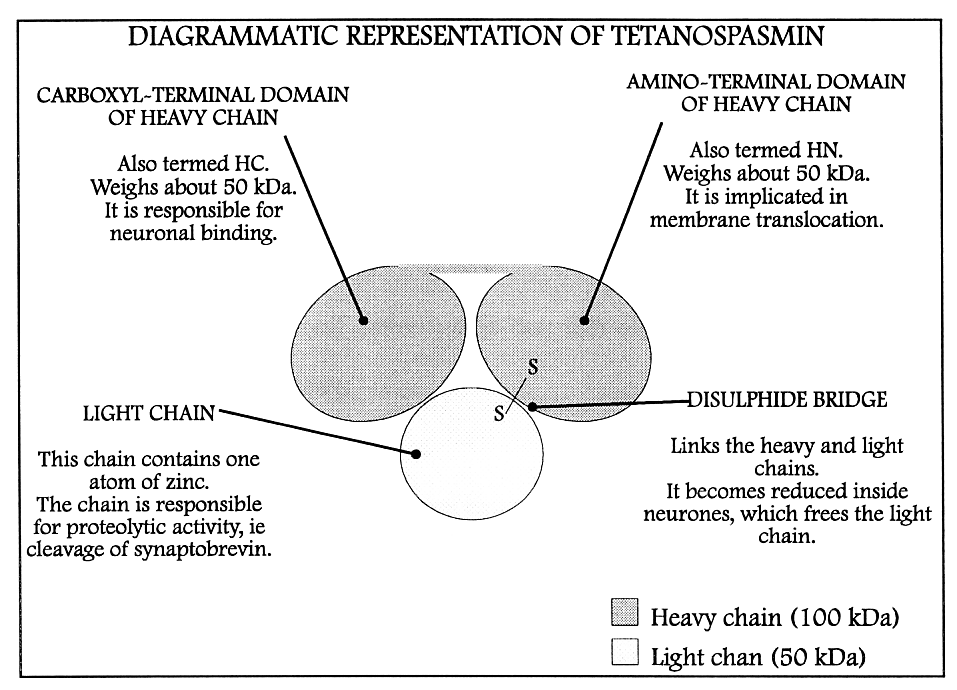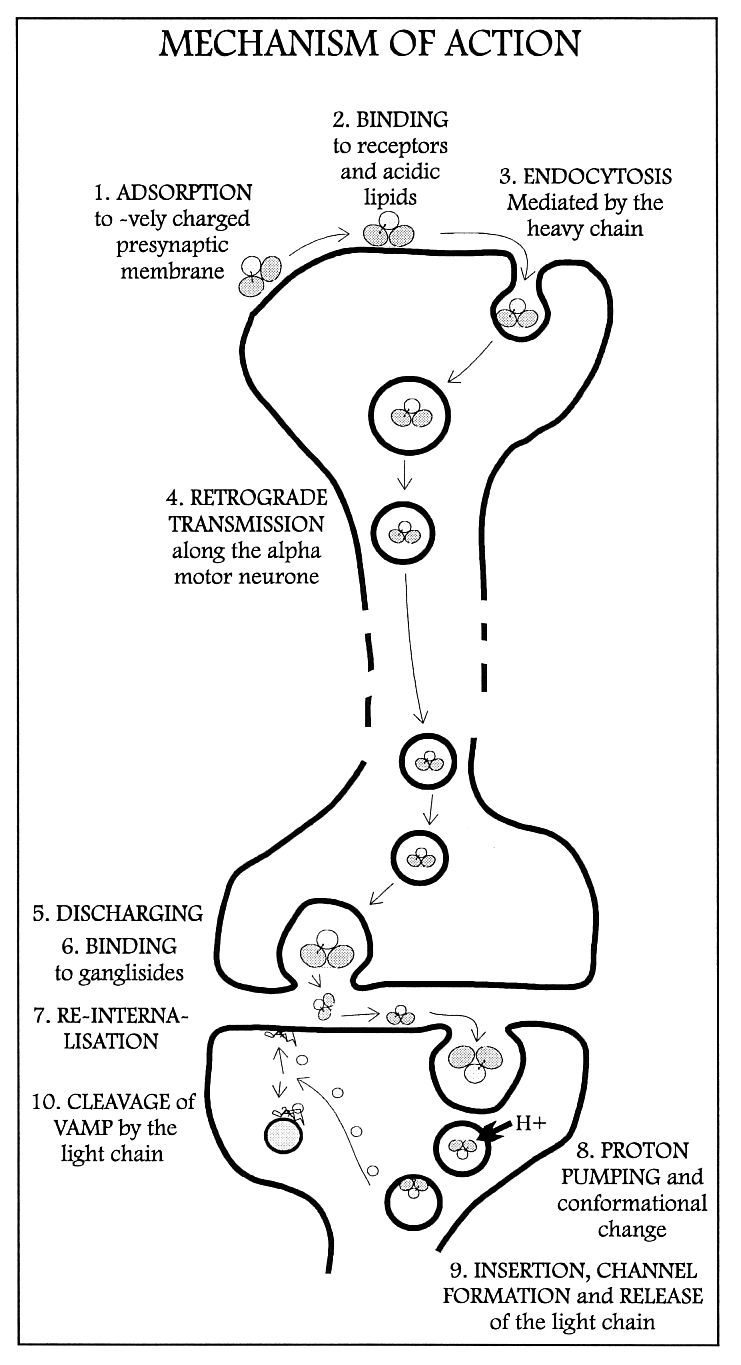
Tetanospasmin
Encyclopedia


Neurotoxin
A neurotoxin is a toxin that acts specifically on nerve cells , usually by interacting with membrane proteins such as ion channels. Some sources are more general, and define the effect of neurotoxins as occurring at nerve tissue...
produced by the vegetative cell of Clostridium tetani
Clostridium tetani
Clostridium tetani is a rod-shaped, anaerobic bacterium of the genus Clostridium. Like other Clostridium species, it is Gram-positive, and its appearance on a gram stain resembles tennis rackets or drumsticks. C. tetani is found as spores in soil or in the gastrointestinal tract of animals. C...
in anaerobic
Hypoxia (environmental)
Hypoxia, or oxygen depletion, is a phenomenon that occurs in aquatic environments as dissolved oxygen becomes reduced in concentration to a point where it becomes detrimental to aquatic organisms living in the system...
conditions, causing tetanus
Tetanus
Tetanus is a medical condition characterized by a prolonged contraction of skeletal muscle fibers. The primary symptoms are caused by tetanospasmin, a neurotoxin produced by the Gram-positive, rod-shaped, obligate anaerobic bacterium Clostridium tetani...
. It has no known function for clostridia in the soil environment where they are normally encountered. It is also called spasmogenic toxin, tetanospasmin or abbreviated to TeTx or TeNT. The LD50 of this toxin has been measured to be approximately 1 ng/kg, making it second only to Botulinin toxin D
Botulinum toxin
Botulinum toxin is a protein produced by the bacterium Clostridium botulinum, and is considered the most powerful neurotoxin ever discovered. Botulinum toxin causes Botulism poisoning, a serious and life-threatening illness in humans and animals...
as the deadliest toxin in the world. It should be noted however, that these tests are conducted solely on mice which may react differently to certain toxins than humans and other animals.
C. tetani also produces the exotoxin
Exotoxin
An exotoxin is a toxin excreted by a microorganism, like bacteria, fungi, algae, and protozoa. An exotoxin can cause damage to the host by destroying cells or disrupting normal cellular metabolism. They are highly potent and can cause major damage to the host...
tetanolysin
Tetanolysin
Tetanolysin is a toxin produced by Clostridium tetani bacteria. Its function is unknown but it is believed to contribute to the pathogenesis of tetanus.The other C. tetani toxin, tetanospasmin, is more definitively linked to tetanus....
, the effects of which are as yet unclear.
Distribution
Tetanus toxin spreads through tissue spaces into the lymphaticLymphatic system
The lymphoid system is the part of the immune system comprising a network of conduits called lymphatic vessels that carry a clear fluid called lymph unidirectionally toward the heart. Lymphoid tissue is found in many organs, particularly the lymph nodes, and in the lymphoid follicles associated...
and vascular systems. It enters the nervous system at the neuromuscular junction
Neuromuscular junction
A neuromuscular junction is the synapse or junction of the axon terminal of a motor neuron with the motor end plate, the highly-excitable region of muscle fiber plasma membrane responsible for initiation of action potentials across the muscle's surface, ultimately causing the muscle to contract...
s and migrates through nerve trunks and into the central nervous system
Central nervous system
The central nervous system is the part of the nervous system that integrates the information that it receives from, and coordinates the activity of, all parts of the bodies of bilaterian animals—that is, all multicellular animals except sponges and radially symmetric animals such as jellyfish...
(CNS) by retrograde axonal transport by using dynein
Dynein
Dynein is a motor protein in cells which converts the chemical energy contained in ATP into the mechanical energy of movement. Dynein transports various cellular cargo by "walking" along cytoskeletal microtubules towards the minus-end of the microtubule, which is usually oriented towards the cell...
s.
Structure
The proteinProtein
Proteins are biochemical compounds consisting of one or more polypeptides typically folded into a globular or fibrous form, facilitating a biological function. A polypeptide is a single linear polymer chain of amino acids bonded together by peptide bonds between the carboxyl and amino groups of...
tetanus toxin has a molecular weight of 150kDa. It is made up of two parts: a 100kDa heavy or B-chain and a 50kDa light or A-chain. The chains are connected by a disulfide bond.
- The B-chain binds to disialogangliosides (GD2 and GD1b) on the neuronal membrane.
- The A-chain, a zinc endopeptidase, attacks the vesicle-associated membrane protein (VAMP).
The genes encoding these proteins are located on separate plasmids within the bacterium.
Function
The action of the A-chain stops the affected neurons from releasing the inhibitory neurotransmitterNeurotransmitter
Neurotransmitters are endogenous chemicals that transmit signals from a neuron to a target cell across a synapse. Neurotransmitters are packaged into synaptic vesicles clustered beneath the membrane on the presynaptic side of a synapse, and are released into the synaptic cleft, where they bind to...
s GABA
Gabâ
Gabâ or gabaa, for the people in many parts of the Philippines), is the concept of a non-human and non-divine, imminent retribution. A sort of negative karma, it is generally seen as an evil effect on a person because of their wrongdoings or transgressions...
(gamma-aminobutyric acid) and glycine
Glycine
Glycine is an organic compound with the formula NH2CH2COOH. Having a hydrogen substituent as its 'side chain', glycine is the smallest of the 20 amino acids commonly found in proteins. Its codons are GGU, GGC, GGA, GGG cf. the genetic code.Glycine is a colourless, sweet-tasting crystalline solid...
by degrading the protein synaptobrevin
Synaptobrevin
Synaptobrevins are small integral membrane proteins of secretory vesicles with molecular weight of 18 kilodalton that are part of the vesicle-associated membrane protein family....
. The consequence of this is dangerous overactivity in the muscle
Muscle
Muscle is a contractile tissue of animals and is derived from the mesodermal layer of embryonic germ cells. Muscle cells contain contractile filaments that move past each other and change the size of the cell. They are classified as skeletal, cardiac, or smooth muscles. Their function is to...
s from the smallest stimulus—the failure of inhibition of motor reflexes by sensory stimulation. This causes generalized contractions of the agonist and antagonist musculature, termed a tetanic spasm.
Clinical significance
Tetanic spasms can occur in a distinctive form called opisthotonos and be sufficiently severe to fracture long bones. The shorter nerves are the first to be inhibited, which leads to the characteristic early symptoms in the face and jaw, risus sardonicusRisus sardonicus
Risus sardonicus is a highly characteristic, abnormal, sustained spasm of the facial muscles that appears to produce grinning.The name of the condition derives from the appearance of raised eyebrows and an open "grin" - which can appear malevolent to the lay observer - displayed by those suffering...
and lockjaw
Tetanus
Tetanus is a medical condition characterized by a prolonged contraction of skeletal muscle fibers. The primary symptoms are caused by tetanospasmin, a neurotoxin produced by the Gram-positive, rod-shaped, obligate anaerobic bacterium Clostridium tetani...
.
The toxin bind to the neurons is irreversible and nerve function can only be returned by the growth of new terminals and synapses.
Immunity and vaccination
Due to its extreme potency, even a lethal dose of tetanospasmin may be insufficient to provoke an immune response. Naturally-acquired tetanus infections thus do not usually provide immunity to subsequent infections. Immunization (which is impermanent and must be repeated periodically) instead utilizes the less deadly toxoidToxoid
A toxoid is a bacterial toxin whose toxicity has been weakened or suppressed either by chemical or heat treatment, while other properties, typically immunogenicity, are maintained. In international medical literature the preparation also is known as Anatoxin or Anatoxine...
derived from the toxin, as in the tetanus vaccine
Tetanus vaccine
Tetanus vaccine is a vaccine used against Clostridium tetani, the agent that causes tetanus.The vaccine is composed of tetanus toxoid, tetanus toxin inactivated with formaldehyde, which is immunogenic but not pathogenic. It is a component of the DPT vaccine.The tetanus vaccine is required again...
and some combination vaccines such as DPT
DPT vaccine
DPT refers to a class of combination vaccines against three infectious diseases in humans: diphtheria, pertussis and tetanus...
.

